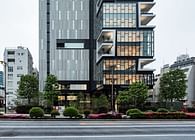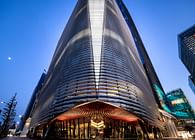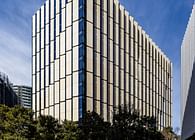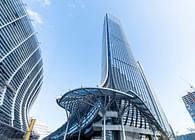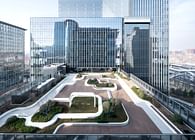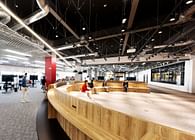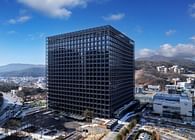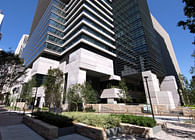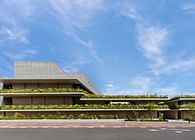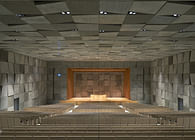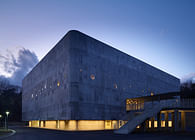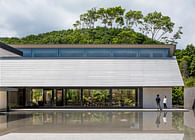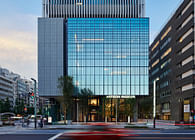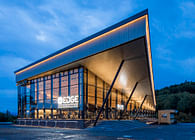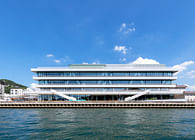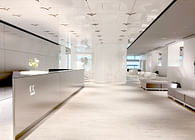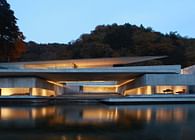
This project is a rebuild of the Kikkoman research laboratory in Noda City, Chiba Prefecture, northeast of Tokyo. Soy sauce production began there more than 200 years ago when over a dozen families started a brewing cooperative, which eventually evolved into today’s Kikkoman.
The area around the site is dotted with traditional streets that reflect this history. Kikkoman's former research laboratory, by contrast, was a concrete building over 60 years old. We felt that for research on soy sauce and food products, a site sensitive to the changes of seasons, time, the five senses and continuity with nature would be appropriate. In fact, our client requested a facility in which researchers could enjoy work while experiencing the nuanced shifts in the natural surroundings.
Input for this ‘inheritor design’ was drawn from the traditional soy sauce production landscape around the site. Originally, streets were connected to narrow alleyways, and several row houses were clustered together to form a series of breweries, stores and homes, with courtyard-like spaces scattered in between. In deferring to these attributes, maximizing horizontal (as opposed to vertical) expanse was deemed necessary. The 10,000m² building was thus accommodated in just two storeys, with a simple configuration of experimental areas on the first floor and offices and other open spaces on the second floor.
The spacious first floor is designed for maximize flexibility. When viewed from above, workspaces on the second floor appear to be arranged in a checkerboard pattern of “open” quadrilaterals mixed with work areas. Atriums, courtyards, and terraces are featured in the adjacent “inverted” checkerboard area. The floor level shifts slightly with each “box” in the checkerboard, creating an unusual topography.
Gabled roofs are partially “flipped upwards” where there is an atrium below, inviting in light and wind. The first and second floors offer a feel for the fluctuation of nature regardless of where the observer is -- a comfort for those whose view of public health may have shifted due to the recent virus pandemic.
Manufacturing soy sauce is classic chemistry – a process once performed in a space contiguous with the cityscape and natural environment. The Kikkoman project was based on this traditional context, and subtly modified during the design process. Rather than whittling down and refining the constituent elements, each was, in a manner of speaking, “multiplied” and “fermented.” The final aim was to create an architecture both topographical and emotional, with a sense of natural change, along with an easy-to-grasp sense of harmony with nature and tradition.
Stepped floor
The 2F checkerboard floor level changes by 350mm per quadrilateral area, concealing the air conditioning ducts installed underneath. The first floor 4,950mm height ensures sufficient space for piping and ducting redundancy above the lab. The stairwell landing is some 1,000mm lower than the second floor, creating a maximum floor level difference of 1,700mm at the second floor. The basin-like topography of the building makes for a relaxing space, while the high sidelights, courtyard, and exterior terrace afford visitors a feel for nature from any vantage point.
Selective use of glass and wall balustrades offer differing vantage points depending on the floor level, as well as different lines-of-sight between standing and sitting positions. In an area where floor levels change by some 700mm, a 1,100mm balustrade effectively serves as a 1,800mm (700mm+1,100mm) partition, creating a sense of “enclosed contiguity” fit for concentration-intensive work. Wall balustrade units also serve as air-conditioning inlets that work in harmony with the floor-mounted A/C outlets, facilitating air circulation. By adding features that control the line-of-sight to the simple checkered landscape, a variegated, inspiring space for company researchers was created.
Facility name: Kikkoman R&D Center
Main use: Research institute
Client: Kikkoman Corporation
Site area: 16,960m²
Total floor area: 11,707m²
Number of floors: Two floors above ground
Maximum height: GL+12.98m
Main structure:Steel structure (with seismic isolation)
Construction period: July 2018 - August 2019
Status: Built
Location: Chiba prefecture, Noda City, Japan
Firm Role: Schematic design and design development review
Additional Credits: KAJIMA CORPORATION (Design development)
KAJIMA CORPORATION (Construction)
